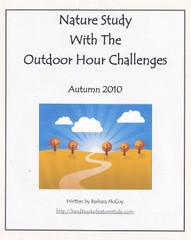Today we went on a drive up in the mountains and would you believe there was snow! I spotted some freshly fallen pinecones and it was a perfect introduction to this week's challenge. The snowy landscape reminded me that we will soon be finished with the Autumn Series and it will be time for a new season to start. The Autumn Series of Outdoor Hour Challenges has greatly added to our family's knowledge of everyday things around us and I hope they have helped your family too. Next week will be our last autumn challenge and a nice giveaway so make sure to pop over to the blog next Friday to read all about it.
Autumn Series #9
Pine Cones
“Their foliage is evergreen but is shed gradually. The pollen-bearing and the seed-producing flowers are separate on the tree. The seeds are winged and are developed in cones.”
Handbook of Nature Study, page 674
Inside Preparation Work:
Read pages 670-675 in the Handbook of Nature Study (Lesson 185). This section talks about the pine tree and gives the background for this challenge. Pay attention to questions 5 and 6 in this lesson covering the pine cone. (You may find it helpful to read this Treasures in a Pinecone link before going outdoors to look at pine cones.)
Compare A Tree with Cones and A Tree Without Cones
(Use the Venn Diagram to Record Your Observations.)Compare needles and leaves, including their arrangement on the branches, shapes, and colors.
Compare the trunks and bark, including the shape of the tree. Does the main trunk go straight up or branch out? How low do the branches start? Is there a crown?
Outdoor Hour Time:
Take fifteen minutes outdoors this week to explore your yard or neighborhood looking for a pine tree and pine cones. Remember how to identify a pine tree and use some of the things you read about in the Handbook to help your child learn a little about the pine tree. You could point out the difference between an evergreen and a deciduous tree, how the pine tree’s leaves are needles, the distinct shape of a pine tree, and the cones. Collect at least one cone to bring indoors for observations in the follow-up activity.
Follow-Up Activity:
Use a hand lens to look closely at your pine cone. Take note of its shape, size, color, and patterns. The Handbook of Nature Study suggests the following sketches in your nature journal:
- Bundle of needles, showing the sheath and its attachment to the twig.
- The cone.
- The cone scale.
- The seed (under the scales)
Additional activity: Soak your cone in water. Check your cone every 15 minutes to see what happens. Now let the cone dry. This sometimes will loosen the seeds inside and you can take a closer look at their shapes and structure. Try this activity again and soak only half your cone in water and see what happens. More activities with cones are found at these links: Treasures in a Pinecone and Pinecone Weather.
Additional Resources:
Help in identifying pines and this one with pines by region
A Pine Cone Tale: This link will be helpful if you don’t have access to a pine tree to observe and the formation of cones.
Don't forget that there are additional resources and ideas for autumn nature study on my Squidoo website: Outdoor Hour Challenge-Autumn Series.


